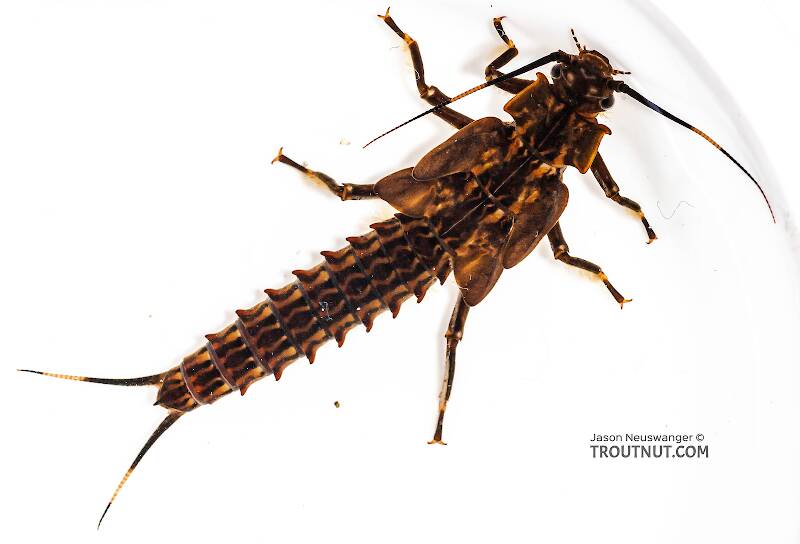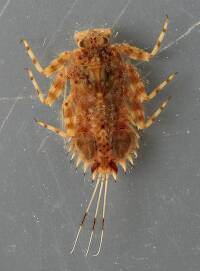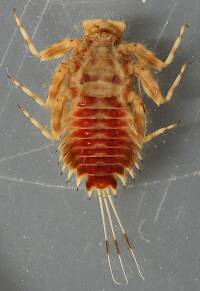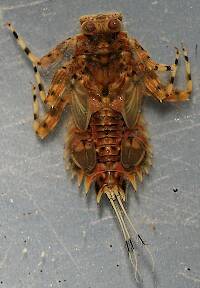
Blue-winged Olives
Baetis
Tiny Baetis mayflies are perhaps the most commonly encountered and imitated by anglers on all American trout streams due to their great abundance, widespread distribution, and trout-friendly emergence habits.
Featured on the forum

Troutnut is a project started in 2003 by salmonid ecologist Jason "Troutnut" Neuswanger to help anglers and
fly tyers unabashedly embrace the entomological side of the sport. Learn more about Troutnut or
support the project for an enhanced experience here.
GONZO on May 19, 2007May 19th, 2007, 12:01 pm EDT
Jason,
When I first looked at this specimen, my first instinct was to guess that it was biloba, especially coming from the upper Neversink. But, the more I compare it to the specimen I previously guessed as biloba, the more I see subtle differences. The pronotum is a different shape and the knobs or spines extend further along the abdomen. Perhaps these are variable traits or gender differences, but I'm starting to wonder about both IDs.
Of the Eastern (or transcontinental) species, I'm pretty familiar with dorsata and biloba, and I've seen a few specimens that I'm pretty sure are comstocki. These latter specimens had fearsome-looking long spines along the abdomen and I guessed at the comstocki ID mostly because its nickname is the "spiny salmonfly."
I've seen cladistic diagrams that indicate that scotti is considered to be the closest relative of biloba, but it seems to have a more southerly distribution. (That diagram also seemed to explain why Allonarcys is no longer favored as a separate genus for the Pteronarcys species with spines or knobs.)
I'm not aware of the species descriptions of proteus or pictetii. Until I saw a survey of the Delaware River basin, I assumed that the large unknobbed Pteronarcys that I had seen on the main branch were dorsata (and that's what Ernie S. said they were), but the survey lists only biloba, comstocki, and proteus.
Could someone provide some characters for these other species? It would help to resolve my current confusion and would be greatly appreciated.
When I first looked at this specimen, my first instinct was to guess that it was biloba, especially coming from the upper Neversink. But, the more I compare it to the specimen I previously guessed as biloba, the more I see subtle differences. The pronotum is a different shape and the knobs or spines extend further along the abdomen. Perhaps these are variable traits or gender differences, but I'm starting to wonder about both IDs.
Of the Eastern (or transcontinental) species, I'm pretty familiar with dorsata and biloba, and I've seen a few specimens that I'm pretty sure are comstocki. These latter specimens had fearsome-looking long spines along the abdomen and I guessed at the comstocki ID mostly because its nickname is the "spiny salmonfly."
I've seen cladistic diagrams that indicate that scotti is considered to be the closest relative of biloba, but it seems to have a more southerly distribution. (That diagram also seemed to explain why Allonarcys is no longer favored as a separate genus for the Pteronarcys species with spines or knobs.)
I'm not aware of the species descriptions of proteus or pictetii. Until I saw a survey of the Delaware River basin, I assumed that the large unknobbed Pteronarcys that I had seen on the main branch were dorsata (and that's what Ernie S. said they were), but the survey lists only biloba, comstocki, and proteus.
Could someone provide some characters for these other species? It would help to resolve my current confusion and would be greatly appreciated.
Quick Reply
Related Discussions
Topic
Replies
Last Reply
1
Oct 28, 2008
by GONZO
by GONZO
4
Sep 4, 2012
by Entoman
by Entoman
2
Oct 4, 2006
by GONZO
by GONZO
5
Jul 31, 2020
by Creno
by Creno






